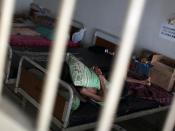HIV And Its Effects 1 HIV And Its Effects Psychology 102 October 10, 2001 HIV And Its Effects 2 HIV AND Its Effects The effects HIV has on a person, symptoms, risks, history and prevention will be explained. HIV is on a rise among sexually active people. According to Packer (1998), HIV, the virus that causes acquired immune deficiency syndrome (AIDS), is a member of a family of viruses. The first member HTLV-I and related to STLV-I researchers believe they both have a common ancestor in Africa. (P.13).
This will be explained in the following questions: 1. What are the symptoms of HIV? 2. What are the risks to getting HIV? 3. What is the history of HIV? 4. What is the treatment for HIV? This research paper on HIV will be focused on these four questions.
1. What are the symptoms of HIV? According to Nash (1997), when a person infected with HIV has symptoms such as fever, night sweats, weight loss, fatigue, and lymphadenopathy (persistent, unexplained swelling of the lymph nodes), but no opportunistic infections (illnesses that healthy immune systems fight off) or Kaposi's sarcoma, he is said to have AIDS-related complex (ARC).
The acronym ARC is not used as frequently as it was in the early years of the epidemic. AIDS is now thought of in term of a HIV continuum. It begins with HIV-positive diagnosis in a person who is not experiencing any symptoms. It continues to a symptomatic stage in which the person has opportunistic infections, HIV and Its Effects 3 andKaposi's sarcoma, or any of the conditions previously used to define Arc, and the HIV-positive continuum ends with full-blown AIDS diagnosis (p.22).
2. What are the risks to getting HIV? According to Nash (1997) No one is safe if his or her behavior is...


